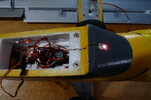Hi Guys/Gals,
I recently removed and replaced all the electronics from a severally damaged HBZ Carbon Cub 1.3 fuselage into a new one. I added the flap servo to the wing as well. All functions were working according to plan. The plane took off as normal, but shortly after takeoff the motor quit. Landed w/o damage. I noted that the light in the Safe Control had changed from green to red. I checked all connections and the battery was over 50% charged. On the ground the motor ran as normal, but the aileron servos jittered when activated. Flew it again with the same results. (DUH) There is no mention of this phenomenon in the trouble shooting guide.
There is no mention of this phenomenon in the trouble shooting guide.
Any suggestions or advice gratefully accepted.
I recently removed and replaced all the electronics from a severally damaged HBZ Carbon Cub 1.3 fuselage into a new one. I added the flap servo to the wing as well. All functions were working according to plan. The plane took off as normal, but shortly after takeoff the motor quit. Landed w/o damage. I noted that the light in the Safe Control had changed from green to red. I checked all connections and the battery was over 50% charged. On the ground the motor ran as normal, but the aileron servos jittered when activated. Flew it again with the same results. (DUH)
 There is no mention of this phenomenon in the trouble shooting guide.
There is no mention of this phenomenon in the trouble shooting guide.Any suggestions or advice gratefully accepted.





 It's been clobbered quite hard, but everything functioned as it was supposed to at first.
It's been clobbered quite hard, but everything functioned as it was supposed to at first.
 I haven't had the chance to test it in flight yet, but my bet is that it works.
I haven't had the chance to test it in flight yet, but my bet is that it works.